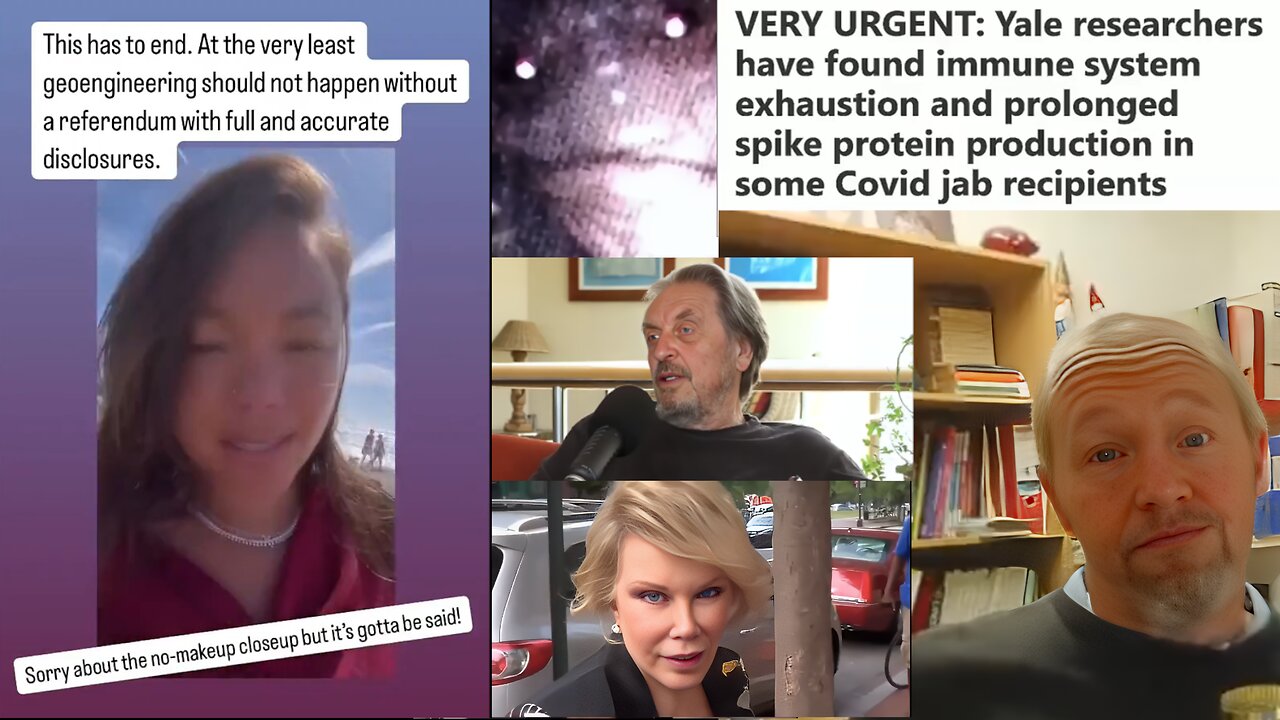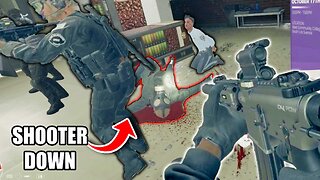Premium Only Content

( -0855 ) Today the Question Isn't, "Do You Believe in 'Conspiracy Theories'?", the Question is Who Doesn't ( Yale Preprint of Study Says Spike Protein is Present 709 Days After mRNA Covid-19 Vaccines... )
( -0855 ) Today the Question Isn't Do You Believe a 'Conspiracy Theory', the Question is Who Doesn't. (Yale Preprint of Study Says Spike Protein is Present 709 Days After Jab)
Elizondo, Gordon Cooper, Greer, Debra, Trapp, Michael Riconosciuto, Danny Casolaro, Roger Rabbit, Octopus, PROMIS software, AI, October Surprise, Christian Hansen, Tulsi, RFK Jr, Kash Patel, Bondi, timeline, ET, UAV, UAS, UFO, USO, extraterrestrial, exopolitics, Blue Beam, Philadelphia Experiment, Montauk, Buckaroo Bonzai, Orson Welles, War of the Worlds, MAGA, Drones, New Jersey, NJ, pardon, Hunter, crack, Ukraine, tWitch, Stephen Boss, Ellen Degeneres, Anne Heche, Jackie Walorski, Cathy O'Brien, Anneke Lucas, Bush, PBD, Valuetainment, pipeline, energy, fluoride, fluoridation, FEMA, camp, warpspeed, Byrne, Vance, gay, homosexual, bisexual, open marriage, swinger, trans, Rogan, Hewell, Fauci, Greenwald, Colorado, Supreme Court, Trump, 9-11, Rachel, Chandler, Epstein, Balenciago, Weinstein, Cullen, Scavino, Dominion, Smartmatic, election, fraud, vote, flipping, Pizzagate, Hillary, Walz, pedophile, exchange, student, Hitler, lock, up, prison, Usher, Stiller, Simon, Cowell, Eminem, Oprah, DiCaprio, JLo, Jennifer Lopez, Diddy, Helene, Milton, hurricane, Weather, Warfare, military, industrial, complex, storm, geoengineering, NC, North, Carolina, conspiracy, election, weapon, dam, globalist, lithium, quartz, Lake Lure, failure, Asheville, Colonel, McGreggor, Dane, Wigington, heist, steal, votes, upon, immigration, citizen, rights, 1st Amendment, 2nd Amendment, lawfare, suppression, criminal, elite, Haliburton, voltage, electromagnetic, DEW, pulse, injustice, democracy, republic, WEF, Kerry, Hillary, Clinton, 2030, agenda, sustainability, windfarms, Bird Flu, Avian Flu, mRNA, turnout, register, fraud, white, hats, Qanon, Storm, patriots, patriotic, America, military, industrial, complex, geoengineering, NC, North, Carolina, Lucifer, conspiracy, election, dam, globalist, information warfare, information, warfare, Wayfair, waif, Vegas, shooting, Bellagio, MAHA, Trump Surgeon General, Dr. Janette Nesheiwat,
https://disinformationchronicle.substack.com/p/yale-researchers-find-covid-spike
Given this information, you should be able to search on medRxiv for the preprint titled "Immunological and Antigenic Signatures Associated with Chronic Illnesses after COVID-19 Vaccination" by Akiko Iwasaki and colleagues.
https://pubmed.ncbi.nlm.nih.gov/37986769/
The DisInformation Chronicle
SubscribeSign in
Yale Researchers Find COVID Spike Protein in Blood 709 Days After Vaccination, Positing Millions of Long COVID Patients May Actually Be Vaccine Injured
NIH has poured $1.6 billion into Long COVID research, but little or nothing to study vaccine harms, causing patient advocates to hide vaccine injury.
PAUL D. THACKER
FEB 19, 2025
274
15
60
Share
9 minute read
Yale researchers released a study today that posits millions of Americans thought to have Long COVID may have been misdiagnosed and actually have post-vaccination syndrome caused by exposure to the spike protein in COVID vaccines. Spike protein produced by the Pfizer and Moderna vaccines triggers the body’s immune response, and the FDA claimed in a 2023 Politifact fact check that vaccine spike protein is not toxic and does not linger in the body. However, Yale researchers report that some patients, who were never infected with COVID virus, were sick with post-vaccination syndrome (PVS) and had elevated levels of virus spike protein in their blood up to 709 days after vaccination.
“There is considerable overlap in self-reported symptoms between long COVID and PVS, as well as shared exposure to SARS-CoV-2 spike (S) protein in the context of inflammatory responses during infection or vaccination,” noted the study authors.
NIH has poured $1.6 billion into Long COVID research, while ignoring patients harmed by COVID vaccines, causing some well-known patient advocates to hide vaccine injury. After a 13-month battle with Long COVID, Hollywood screenwriter Heidi Ferrer took her own life after deciding death was preferable to another minute in her own “personal hell." Death of the Dawson’s Creek writer made headlines across the media including places such as People, the Guardian, Variety, CNN, Newsweek, and The Daily Mail—each recounting Ferrer’s struggle with Long COVID.
But in a private video circulating among patient groups and obtained by The DisInformation Chronicle, Ferrer’s husband Nick Guthe stated that Moderna’s COVID vaccine was the final straw, causing Heidi to develop tremors and then internal vibrations when she lay down for bed, so that even prescription sleeping pills would not allow her to sleep.
“And that’s when things turned,” Guthe said in the video.
Prominent patient advocate Beth Mazur also committed suicide after a COVID vaccine apparently worsened her struggles with myalgic encephalomyelitis (ME), a chronic illness with many similarities to Long COVID. Mazur co-founded #MEAction for patients with chronic illness. #MEAction reported in early 2021 that a significant number of ME/CFS patients experienced “both new symptoms and long-lasting exacerbations of their pre-existing ME/CFS symptoms” after a COVID vaccine.
“Beth was a compassionate advocate for ME/CFS and a fierce advocate for vaccine injury after she experienced this herself sometime before she took her own life,” said one of Mazur’s personal friends who did not wish to be identified. “Having people come after you for vaccine injury is worse than being sick itself. And people can’t handle that. It’s a shroud of shame.”
One of the study’s lead authors, Yale Medical School’s Akiko Iwasaki, previously shot down public concerns about COVID vaccine side effects. When Houston Methodist Hospital staffers sued to avoid the hospital’s coronavirus vaccine mandate in 2021, Iwasaki told the Washington Post that the employees’ fears were “absurd” because “no safety concerns” had been found in the mRNA vaccine clinical trials.
Along with other prominent health experts, Iwasaki also signed a petition supporting the OSHA COVID-19 vaccine mandate which the Supreme Court later blocked.
Several of the study’s findings as well as research the authors cite in their paper have been labeled as false by federal agencies, medical experts, and fact checkers. Because medical journals have been rejecting studies on vaccine side effects, the authors uploaded their paper to the preprint site medRxiv.
Passages from the paper are examined below, as well as “fake fact checks” with false and misleading statements by federal agencies and medical experts that, in the past, called these new scientific findings fallacious. Hyperlinks to research papers cited by the study authors have been added to replace their footnotes.
________________________________________
Immunological and Antigenic Signatures Associated with Chronic Illnesses after COVID-19 Vaccination
Yale researchers point out that vaccine injury has not been totally defined and has been labeled both PVS and PACVS. Unlike Long COVID, health authorities do not officially recognize PVS, so patients get little support or care. See passage from paper:
In addition, some individuals have reported post-vaccination symptoms resembling long COVID beginning shortly after vaccination. This condition, sometimes referred to as post-vaccination syndrome (PVS) or post-acute COVID-19 vaccination syndrome (PACVS), is characterized by symptoms such as exercise intolerance, excessive fatigue, numbness, brain fog, neuropathy, insomnia, palpitations, myalgia, tinnitus or humming in ears, headache, burning sensations, and dizziness. Unlike long COVID, PVS is not officially recognized by health authorities, which has significantly limited patient care and support.
Both Long COVID and PVS rely on patient’s self-reported symptoms, which have quite a bit in common. Exposure to the spike protein during infection or vaccination causes inflammation. Various parts of the mRNA vaccine might also be problematic such as the mRNA itself which then creates the spike protein, or the tiny fat globule that encases vaccine mRNA called a lipid nanoparticle.
However, there is considerable overlap in self-reported symptoms between long COVID and PVS, as well as shared exposure to SARS-CoV-2 spike (S) protein in the context of inflammatory responses during infection or vaccination. In susceptible individuals, vaccines may contribute to long-term symptoms by multiple mechanisms. For example, vaccine components, such as mRNA, lipid nanoparticles, and adenoviral vectors, trigger activation of pattern recognition receptors.
Share
FAKE FACT CHECK: In a 2021 fact check, AP claimed spike protein from COVID vaccines are not toxic.
The Pfizer and Moderna vaccines create a spike protein that is also called “S protein” or “S1”. See passage from paper:
Secondly, it has been shown that the S protein expressed following BNT162b2 [Pfizer] or mRNA-1273 [Moderna] vaccination circulates in the plasma as early as one day after vaccination.
The virus spike protein has two parts called S1 and S2. These might break down into smaller units called peptides. Some patients with PVS have been found with S protein in their blood cells. In animals, the mRNA vaccine has been found to cross over a membrane and enter the brain. If the mRNA then created spike protein, this could cause neurological problems.
Interaction with full-length S, its subunits (S1, S2), and/or peptide fragments with host molecules may result in prolonged symptoms in certain individuals. Recently, a subset of non-classical monocytes has been shown to harbor S protein in patients with PVS. Further, biodistribution studies on mRNA–LNP platforms in animal models indicate its ability to cross the blood-brain barrier, and the local S expression could result in neurocognitive symptoms.
Give a gift subscription
FAKE FACT CHECK: In a March 2021 fact check, Reuters claimed spike protein is broken down after it leaves a cell.
The researcher report that patients with PVS cited the following symptoms:
The most frequent symptoms reported by participants were excessive fatigue (85%), tingling and numbness (80%), exercise intolerance (80%), brain fog (77.5%), difficulty concentrating or focusing (72.5%), trouble falling or staying asleep (70%), neuropathy (70%), muscle aches (70%), anxiety (65%), tinnitus (60%) and burning sensations (57.5%)
Patients reported symptoms from the vaccines around 4 days, and severe symptoms about 10 days after vaccination.
The median number of days for the development of any symptom was 4 [Interquartile range (IQR): 23 days], while for severe symptoms, it was 10 (IQR: 44 days) post-vaccination.
Patients with PVS had higher levels of spike protein or S1 in their blood.
The results indicated that participants with PVS had significantly higher circulating S1 levels compared with the control group (p = 0.01).
This figure from the paper shows that PVS patients had spike protein or S1 in their blood up to 709 days after they were vaccinated.
Leave a comment
FAKE FACT CHECK: In 2023 Politifact alleged the spike protein does not linger in the body after vaccination, based on claims from an FDA official.
PVS and Long COVID share similar symptoms probably from exposure to S protein. Researchers have found the full spike protein and the smaller S1 protein in Long COVID patients. See passage from paper:
Given the similarities between PVS and long COVID symptoms, one hypothesis in the literature is that shared exposure to the S protein may play a role and several groups have independently reported the presence of circulating S1 & full-length S in long COVID using various detection methods.
The highest levels of spike protein were found in PVS patients who had been vaccinated but never infected by COVID virus.
Notably, we observed that the highest levels of detectable S1 in the PVS-I group were the furthest away from the last known exposure and ranging between greater than 600-700 days.
Patients vaccinated with mRNA COVID vaccines and the adenovirus COVID vaccine have shown harm. Patients with PVS had poor health as defined by standardized tests called GHVAS and PROMIS29. Few studies have investigated the cause of PVS, which has no agreed upon definition. See passage from paper:
Post-acute conditions following COVID-19 vaccination have been reported for multiple vaccine platforms including mRNA and adenoviral-vectored vaccines. We observed that the general health status of the PVS participants was far below the general US population average based on the GHVAS scores. The patient-reported outcome scores from the PROMIS29 domains were also indicative of lower quality of life. To date, only a few studies have investigated the immunological mechanisms associated with PVS and no consensus definition of this syndrome exists.
Underlying risk factors for developing PVS are similar for Long COVID. This might be due to problems caused by spike protein, but should be studied further.
The demographics at risk of developing PVS and symptom manifestations are similar to those of long COVID. Whether this reflects overlapping underlying mechanisms such as persistent S protein remains to be determined.
High levels of spike protein in the blood were found in PVS patients who had been infected with the COVID virus and those who had never been infected. This makes sense as spike protein has been found in blood cells. Spike protein has been found in the blood of patients who had myocarditis after COVID vaccination. Because PVS and Long COVID are so similar, the spike protein might be causing the chronic health problems.
By contrast, in our study, significantly elevated levels of circulating S1 and S were observed in a subset of PVS participants both in the infection-naive and infection-positive groups up to 709 days post-exposure. This is in line with the findings of S1 persistence in monocytes in people with PVS. Circulating full-length S has also been detected in cases of post-vaccination myocarditis. Given the striking similarities between long COVID and PVS symptoms, there has been speculation regarding the potential causal role of the persistent presence of spike protein driving the chronic symptoms.
More reporting on vaccine side effects in patients to come.
274 Likes∙
60 Restacks
274
15
60
Share
Discussion about this post
CommentsRestacks
PamelaDrew
4d
Part of the problem is that these were never vaccines but decades old lab tool known as TRANSFECTION and known to be failed therapy in 1999 case of Jesse Gelsinger because human bodies NEVER tolerate foreign proteins. https://web.archive.org/web/20121025034826/https://www.nytimes.com/1999/11/28/magazine/the-biotech-death-of-jesse-gelsinger.html
While spike proteins may make this worse there is no condition where auto-immune damage would not be expected.. but rebranding TRANSFECTION as investigational vaccines takes mop & bucket lab tool and resets IP novel use for cash cow. It was always criminally insane medical experiment on par w lobotomy another Nobel Prize winner decades earlier.
https://web.archive.org/web/20150822064507/https://www.thermofisher.com/us/en/home/references/gibco-cell-culture-basics/transfection-basics.html
LIKE (40)
REPLY
SHARE
Vicki
4d
The many medical issues that will be uncovered may be more earth shattering than the CIA and USAID. https://www.youtube.com/watch?v=o-BCMG198Yc
LIKE (21)
REPLY
SHARE
1 reply
* * *
full preprint:
Search:
Advanced
User Guide
•
•
•
•
Full text links
Actions
Share
•
•
•
•
Page navigation
• Preprint notice
• Title & authors
• Abstract
• Figures
• Similar articles
• References
• Publication types
• Related information
• Grants and funding
• LinkOut - more resources
This is a preprint.
It has not yet been peer reviewed by a journal.
The National Library of Medicine is running a pilot to include preprints that result from research funded by NIH in PMC and PubMed.
medRxiv
•
•
•
[Preprint]. 2023 Nov 10:2023.11.09.23298266.
doi: 10.1101/2023.11.09.23298266.
Post-Vaccination Syndrome: A Descriptive Analysis of Reported Symptoms and Patient Experiences After Covid-19 Immunization
Harlan M Krumholz 1 2 3 4 , Yilun Wu 1 5 , Mitsuaki Sawano 1 3 , Rishi Shah 1 6 , Tianna Zhou 7 , Adith S Arun 7 , Pavan Khosla 7 , Shayaan Kaleem 8 , Anushree Vashist 1 9 , Bornali Bhattacharjee 2 10 , Qinglan Ding 11 , Yuan Lu 1 3 , César Caraballo 1 12 , Frederick Warner 1 3 , Chenxi Huang 1 3 , Jeph Herrin 3 , David Putrino 13 , Danice Hertz 14 , Brianne Dressen 15 , Akiko Iwasaki 2 10 16
Affiliations
• PMID: 37986769
• PMCID: PMC10659483
• DOI: 10.1101/2023.11.09.23298266
Abstract
Introduction: A chronic post-vaccination syndrome (PVS) after covid-19 vaccination has been reported but has yet to be well characterized.
Methods: We included 241 individuals aged 18 and older who self-reported PVS after covid-19 vaccination and who joined the online Yale Listen to Immune, Symptom and Treatment Experiences Now (LISTEN) Study from May 2022 to July 2023. We summarized their demographics, health status, symptoms, treatments tried, and overall experience.
Results: The median age of participants was 46 years (interquartile range [IQR]: 38 to 56), with 192 (80%) identifying as female, 209 (87%) as non-Hispanic White, and 211 (88%) from the United States. Among these participants with PVS, 127 (55%) had received the BNT162b2 [Pfizer-BioNTech] vaccine, and 86 (37%) received the mRNA-1273 [Moderna] vaccine. The median time from the day of index vaccination to symptom onset was three days (IQR: 1 day to 8 days). The time from vaccination to symptom survey completion was 595 days (IQR: 417 to 661 days). The median Euro-QoL visual analogue scale score was 50 (IQR: 39 to 70). The five most common symptoms were exercise intolerance (71%), excessive fatigue (69%), numbness (63%), brain fog (63%), and neuropathy (63%). In the week before survey completion, participants reported feeling unease (93%), fearfulness (82%), and overwhelmed by worries (81%), as well as feelings of helplessness (80%), anxiety (76%), depression (76%), hopelessness (72%), and worthlessness (49%) at least once. Participants reported a median of 20 (IQR: 13 to 30) interventions to treat their condition.
Conclusions: In this study, individuals who reported PVS after covid-19 vaccination had low health status, high symptom burden, and high psychosocial stress despite trying many treatments. There is a need for continued investigation to understand and treat this condition.
PubMed Disclaimer
Figures
Figure 1.. Distribution of health status, measured…
Figure 2.. Top 25 most common symptoms…
Figure 3.. The frequency of treatments tried…
Figure 4.. Top 15 most-tried individual treatments…
Similar articles
• Myocarditis Cases Reported After mRNA-Based COVID-19 Vaccination in the US From December 2020 to August 2021.
Oster ME, Shay DK, Su JR, Gee J, Creech CB, Broder KR, Edwards K, Soslow JH, Dendy JM, Schlaudecker E, Lang SM, Barnett ED, Ruberg FL, Smith MJ, Campbell MJ, Lopes RD, Sperling LS, Baumblatt JA, Thompson DL, Marquez PL, Strid P, Woo J, Pugsley R, Reagan-Steiner S, DeStefano F, Shimabukuro TT. JAMA. 2022 Jan 25;327(4):331-340. doi: 10.1001/jama.2021.24110. PMID: 35076665 Free PMC article.
• Reports of Guillain-Barré Syndrome After COVID-19 Vaccination in the United States.
Abara WE, Gee J, Marquez P, Woo J, Myers TR, DeSantis A, Baumblatt JAG, Woo EJ, Thompson D, Nair N, Su JR, Shimabukuro TT, Shay DK. JAMA Netw Open. 2023 Feb 1;6(2):e2253845. doi: 10.1001/jamanetworkopen.2022.53845. PMID: 36723942 Free PMC article.
• Internal tremors and vibrations in long COVID: a cross-sectional study.
Zhou T, Sawano M, Arun AS, Caraballo C, Michelsen T, McAlpine L, Bhattacharjee B, Lu Y, Khera R, Huang C, Warner F, Iwasaki A, Krumholz HM. medRxiv [Preprint]. 2023 Aug 28:2023.06.19.23291598. doi: 10.1101/2023.06.19.23291598. Update in: Am J Med. 2024 Jul 26:S0002-9343(24)00470-4. doi: 10.1016/j.amjmed.2024.07.008. PMID: 37693623 Free PMC article. Preprint.
• Incidence, risk factors, natural history, and hypothesised mechanisms of myocarditis and pericarditis following covid-19 vaccination: living evidence syntheses and review.
Pillay J, Gaudet L, Wingert A, Bialy L, Mackie AS, Paterson DI, Hartling L. BMJ. 2022 Jul 13;378:e069445. doi: 10.1136/bmj-2021-069445. PMID: 35830976 Free PMC article. Review.
• COVID-19 vaccines: comparison of biological, pharmacological characteristics and adverse effects of Pfizer/BioNTech and Moderna Vaccines.
Meo SA, Bukhari IA, Akram J, Meo AS, Klonoff DC. Eur Rev Med Pharmacol Sci. 2021 Feb;25(3):1663-1669. doi: 10.26355/eurrev_202102_24877. PMID: 33629336 Review.
See all similar articles
References
1.
1. Kouhpayeh H, Ansari H. Adverse events following COVID-19 vaccination: A systematic review and meta-analysis. Int Immunopharmacol 2022;109:108906. doi: 10.1016/j.intimp.2022.108906 [published Online First: 20220530] - DOI - PMC - PubMed
2.
1. Twentyman E, Wallace M, Roper LE, et al. Interim recommendation of the advisory committee on immunization practices for use of the Novavax COVID-19 vaccine in persons aged ≥18 years - United States, July 2022. MMWR Morb Mortal Wkly Rep 2022;71(31):988–92. doi: 10.15585/mmwr.mm7131a2 [published Online First: 20220805] - DOI - PMC - PubMed
3.
1. Tompkins LK, Baggs J, Myers TR, et al. Association between history of SARS-CoV-2 infection and severe systemic adverse events after mRNA COVID-19 vaccination among U.S. adults. Vaccine 2022;40(52):7653–59. doi: 10.1016/j.vaccine.2022.10.073 [published Online First: 20221101] - DOI - PMC - PubMed
4.
1. Pillay J, Gaudet L, Wingert A, et al. Incidence, risk factors, natural history, and hypothesised mechanisms of myocarditis and pericarditis following covid-19 vaccination: Living evidence syntheses and review. BMJ 2022;378:e069445. doi: 10.1136/bmj-2021-069445 [published Online First: 20220713] - DOI - PMC - PubMed
5.
1. Frontera JA, Tamborska AA, Doheim MF, et al. Neurological events reported after COVID-19 vaccines: An analysis of VAERS. Ann Neurol 2022;91(6):756–71. doi: 10.1002/ana.26339 [published Online First: 20220302] - DOI - PMC - PubMed
6.
1. Yousaf AR, Cortese MM, Taylor AW, et al. Reported cases of multisystem inflammatory syndrome in children aged 12–20 years in the USA who received a COVID-19 vaccine, December, 2020, through August, 2021: A surveillance investigation. Lancet Child Adolesc Health 2022;6(5):303–12. doi: 10.1016/s2352-4642(22)00028-1 [published Online First: 20220223] - DOI - PMC - PubMed
7.
1. Nath A. Neurologic complications with vaccines: What we know, what we don’t, and what we should do. Neurology 2023. doi: 10.1212/wnl.0000000000207337 [published Online First: 20230425] - DOI - PMC - PubMed
8.
1. Agrawal V, Sood N, Whaley CM. The impact of the global COVID-19 vaccination campaign on all-cause mortality: National Bureau of Economic Research; Working Paper #31812; October 2023. [Available from: https://www.nber.org/papers/w3181; accessed November 8, 2023.]
9.
1. Centers for Disease Control and Prevention. Safety of COVID-19 vaccines CDC: National Center for Immunization and Respiratory Diseases (NCIRD), Division of Viral Diseases; 2023. [updated Mar.7, 2023. [Available from: https://www.cdc.gov/coronavirus/2019-ncov/vaccines/safety/safety-of-vacc...; accessed November 8, 2023.]
10.
1. Shimabukuro TT, Nguyen M, Martin D, et al. Safety monitoring in the Vaccine Adverse Event Reporting System (VAERS). Vaccine 2015;33(36):4398–405. doi: 10.1016/j.vaccine.2015.07.035 [published Online First: 20150722] - DOI - PMC - PubMed
11.
1. McNeil MM, Gee J, Weintraub ES, et al. The Vaccine Safety Datalink: successes and challenges monitoring vaccine safety. Vaccine 2014;32(42):5390–8. doi: 10.1016/j.vaccine.2014.07.073 [published Online First: 20140806] - DOI - PMC - PubMed
12.
1. Gee J, Marquez P, Su J, et al. First month of COVID-19 vaccine safety monitoring - United States, December 14, 2020-January 13, 2021. MMWR Morb Mortal Wkly Rep 2021;70(8):283–88. doi: 10.15585/mmwr.mm7008e3 [published Online First: 20210226] - DOI - PMC - PubMed
13.
1. Shimabukuro TT, Kim SY, Myers TR, et al. Preliminary findings of mRNA Covid-19 vaccine safety in pregnant persons. N Engl J Med 2021;384(24):2273–82. doi: 10.1056/NEJMoa2104983 [published Online First: 20210421] - DOI - PMC - PubMed
14.
1. Moro PL, McNeil MM. Successes of the CDC monitoring systems in evaluating post-authorization safety of COVID-19 vaccines. Expert Rev Vaccines 2022;21(3):281–84. doi: 10.1080/14760584.2022.2019020 [published Online First: 20220105] - DOI - PubMed
15.
1. Finsterer J. A case report: Long post-COVID vaccination syndrome during the eleven months after the third Moderna dose. Cureus 2022;14(12):e32433. doi: 10.7759/cureus.32433 [published Online First: 20221212] - DOI - PMC - PubMed
16.
1. Couzin-Frankel J, Vogel G. Vaccines may cause rare, Long Covid-like symptoms. Science 2022;375(6579):364–66. doi: 10.1126/science.ada0536 [published Online First: 20220127] - DOI - PubMed
17.
1. Safavi F, Gustafson L, Walitt B, et al. Neuropathic symptoms with SARS-CoV-2 vaccination. medRxiv 2022. doi: 10.1101/2022.05.16.22274439 [published Online First: 20220517] - DOI
18.
1. Notarte KI, Catahay JA, Velasco JV, et al. Impact of COVID-19 vaccination on the risk of developing long-COVID and on existing long-COVID symptoms: A systematic review. EClinicalMedicine 2022;53:101624. doi: 10.1016/j.eclinm.2022.101624 [published Online First: 20220827] - DOI - PMC - PubMed
19.
1. Zhou T, Sawano M, Arun AS, et al. Internal tremors and vibrations in long COVID: A cross-sectional study. medRxiv 2023:2023.06.19.23291598. doi: 10.1101/2023.06.19.23291598 - DOI - PubMed
20.
1. Jiang R, Janssen MFB, Pickard AS. US population norms for the EQ-5D-5L and comparison of norms from face-to-face and online samples. Qual Life Res 2021;30(3):803–16. doi: 10.1007/s11136-020-02650-y [published Online First: 20201006] - DOI - PMC - PubMed
21.
1. von Elm E, Altman DG, Egger M, et al. The Strengthening the Reporting of Observational Studies in Epidemiology (STROBE) statement: guidelines for reporting observational studies. Lancet 2007;370(9596):1453–7. doi: 10.1016/S0140-6736(07)61602-X - DOI - PubMed
22.
1. Abara WE, Gee J, Marquez P, et al. Reports of Guillain-Barré syndrome after COVID-19 vaccination in the United States. JAMA Netw Open 2023;6(2):e2253845. doi: 10.1001/jamanetworkopen.2022.53845 [published Online First: 2023/02/02] - DOI - PMC - PubMed
23.
1. Einstein EH, Shahzadi A, Desir L, et al. New-onset neurologic symptoms and related neuro-oncologic lesions discovered after COVID-19 vaccination: Two neurosurgical cases and review of post-vaccine inflammatory responses. Cureus 2021;13(6):e15664. doi: 10.7759/cureus.15664 [published Online First: 2021/07/20] - DOI - PMC - PubMed
24.
1. Finsterer J, Scorza FA. A retrospective analysis of clinically confirmed long post-COVID vaccination syndrome. J Clin Transl Res 2022;8(6):506–08. [published Online First: 20221109] - PMC - PubMed
25.
1. Günther A, Brämer D, Pletz MW, et al. Complicated long term vaccine induced thrombotic immune thrombocytopenia-A case report. Vaccines (Basel) 2021;9(11) doi: 10.3390/vaccines9111344 [published Online First: 2021/11/28] - DOI - PMC - PubMed
26.
1. Magen E, Yakov A, Green I, et al. Chronic spontaneous urticaria after BNT162b2 mRNA (Pfizer-BioNTech) vaccination against SARS-CoV-2. Allergy Asthma Proc 2022;43(1):30–36. doi: 10.2500/aap.2022.43.210111 [published Online First: 2022/01/06] - DOI - PMC - PubMed
27.
1. React19. Science-based support for people suffering from long-term COVID-19 vaccine effects: React 19; 2021. [Available from: https://react19.org/; accessed November 8, 2023.]
28.
1. Gubernot D, Jazwa A, Niu M, et al. U.S. population-based background incidence rates of medical conditions for use in safety assessment of COVID-19 vaccines. Vaccine 2021;39(28):3666–77. doi: 10.1016/j.vaccine.2021.05.016 [published Online First: 20210514] - DOI - PMC - PubMed
29.
1. Crowe JE, Jr. Genetic predisposition for adverse events after vaccination. J Infect Dis 2007;196(2):176–77. doi: 10.1086/518800 - DOI - PubMed
30.
1. Smatti MK, Alkhatib HA, Al Thani AA, et al. Will host genetics affect the response to SARS-CoV-2 vaccines? Historical precedents. Front Med (Lausanne) 2022;9:802312. doi: 10.3389/fmed.2022.802312 [published Online First: 20220311] - DOI - PMC - PubMed
31.
1. Abara WE, Gee J, Delorey M, et al. Expected rates of select adverse events after immunization for coronavirus disease 2019 vaccine safety monitoring. J Infect Dis 2022;225(9):1569–74. doi: 10.1093/infdis/jiab628 - DOI - PMC - PubMed
32.
1. Hause AM, Gee J, Johnson T, et al. Anxiety-related adverse event clusters after Janssen COVID-19 vaccination - five U.S. mass vaccination sites, April 2021. MMWR Morb Mortal Wkly Rep 2021;70(18):685–88. doi: 10.15585/mmwr.mm7018e3 [published Online First: 20210507] - DOI - PMC - PubMed
33.
1. Rosenblum HG, Gee J, Liu R, et al. Safety of mRNA vaccines administered during the initial 6 months of the US COVID-19 vaccination programme: An observational study of reports to the Vaccine Adverse Event Reporting System and v-safe. Lancet Infect Dis 2022;22(6):802–12. doi: 10.1016/s1473-3099(22)00054-8 [published Online First: 20220307] - DOI - PMC - PubMed
34.
1. Oliver SE, Wallace M, See I, et al. Use of the Janssen (Johnson & Johnson) COVID-19 vaccine: updated interim recommendations from the Advisory Committee on Immunization Practices - United States, December 2021. MMWR Morb Mortal Wkly Rep 2022;71(3):90–95. doi: 10.15585/mmwr.mm7103a4 [published Online First: 20220121] - DOI - PMC - PubMed
35.
1. Chapin-Bardales J, Gee J, Myers T. Reactogenicity following receipt of mRNA-based COVID-19 vaccines. JAMA 2021;325(21):2201–02. doi: 10.1001/jama.2021.5374 - DOI - PubMed
36.
1. SeyedAlinaghi S, Karimi A, Pashaei Z, et al. Safety and adverse events related to COVID-19 mRNA vaccines; a systematic review. Arch Acad Emerg Med 2022;10(1):e41. doi: 10.22037/aaem.v10i1.1597 [published Online First: 20220522] - DOI - PMC - PubMed
37.
1. Luxi N, Giovanazzi A, Capuano A, et al. COVID-19 vaccination in pregnancy, paediatrics, immunocompromised patients, and persons with history of allergy or prior SARS-CoV-2 infection: Overview of current recommendations and pre- and post-marketing evidence for vaccine efficacy and safety. Drug Saf 2021;44(12):1247–69. doi: 10.1007/s40264-021-01131-6 [published Online First: 20211105] - DOI - PMC - PubMed
38.
1. Lipkind HS, Vazquez-Benitez G, DeSilva M, et al. Receipt of COVID-19 vaccine during pregnancy and preterm or small-for-gestational-age at birth - eight integrated health care organizations, United States, December 15, 2020-July 22, 2021. MMWR Morb Mortal Wkly Rep 2022;71(1):26–30. doi: 10.15585/mmwr.mm7101e1 [published Online First: 20220107] - DOI - PMC - PubMed
39.
1. Kafadar AH, Tekeli GG, Jones KA, et al. Determinants for COVID-19 vaccine hesitancy in the general population: a systematic review of reviews. Z Gesundh Wiss 2022:1–17. doi: 10.1007/s10389-022-01753-9 [published Online First: 20220919] - DOI - PMC - PubMed
40.
1. Roy DN, Biswas M, Islam E, et al. Potential factors influencing COVID-19 vaccine acceptance and hesitancy: A systematic review. PLoS One 2022;17(3):e0265496. doi: 10.1371/journal.pone.0265496 [published Online First: 20220323] - DOI - PMC - PubMed
-
 8:52
8:52
MetatronGaming
12 hours agoOverwatch 2 New Hero Vendetta La Lupa
100K10 -
 1:37:16
1:37:16
omarelattar
21 hours agoEx-Mafia Boss: I Made $8 Million Every Week Until The FBI Destroyed My Life! What I Learned...
17.8K1 -
 16:18
16:18
Actual Justice Warrior
13 hours agoJasmine Crockett DESTROYED For Epstein Lies
2.01K13 -
 38:25
38:25
Coin Stories with Natalie Brunell
18 hours agoBlackRock's Robbie Mitchnick on Bitcoin ETF Inflows, Risk-On vs Risk-Off & Digital Gold's Future
11K4 -
 15:56
15:56
itsSeanDaniel
2 days agoMarjorie Taylor Greene Finally WENT TOO FAR (Career Over?)
16.8K39 -
 17:41
17:41
Nikko Ortiz
14 hours agoDropping A School Shooter In VR...
12K3 -
 1:47:50
1:47:50
Side Scrollers Podcast
1 day agoSide Scrollers Presents: OVERCOCKED
67.3K24 -
 15:01
15:01
GritsGG
15 hours agoSolo Dubulars! Most Winning Warzone Player Dominates Lobby!
12.1K -
 13:12
13:12
The Pascal Show
20 hours ago $4.69 earnedTYLER'S ARREST FOOTAGE MISSING?! Local Police Claim Tyler Robinson Arrest Footage Has BEEN DELETED?!
18.2K2 -
 LIVE
LIVE
Lofi Girl
2 years agoSynthwave Radio 🌌 - beats to chill/game to
282 watching